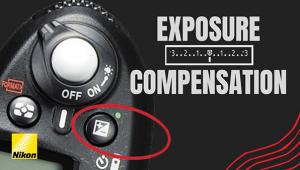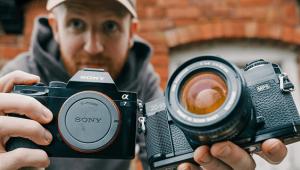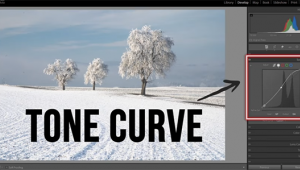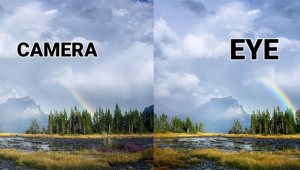Future Report; A Look At What’s Ahead For Photography In 2006…And Beyond Page 2
Let's Ensure That Photography Has A Future
If there is any certainty about the future it is that any of the predictions
any of us make in this series of opinions will be wrong. If we don't want
to see photography in the future relegated to a niche like fresco painting I
think it's more important that we do something today to make sure that
it has a future. The photography industry seems soaked in the belief that "if
we build it they will come" but I think it's time that manufacturers,
organizations, as well as you and me, do something to promote the photographic
hobby to young people.
I find it interesting that one of the few outreach efforts in this area, Digital
Kids Club, is from Adobe (www.adobe.com/education/digkids/main.html),
not one of the so-called mainstream photography manufacturers. Another notable
effort is Jim Miotke's BetterPhoto for Kids and Teens (www.betterphoto.com/photography-for-kids.asp).
We can't count on somebody else to solve the problem; we've got
to get involved on a one-on-one basis. In my own case, I just started mentoring
a 9-year-old girl who was interested in photography and used her grandmother's
camera to make surprisingly interesting images. The only problem: granny lives
in Oregon and Lexie lives in Colorado. I gave her an old digital point-and-shoot
camera so she could make pictures 52 weeks a year, not just two.
Photography isn't just about film or pixels or even the latest lens technology,
it is about people. And so you have to ask yourself: What have I done to make
sure that photography has a future?
--Joe Farace
WEEE And The Future
The European Directive on Waste Electrical and Electronic Equipment (WEEE) is
going to have a major influence on the future of digital photography, even in
the US. Basically, WEEE places upon manufacturers of electrical and electronic
equipment the obligation to accept their products for disposal at the end of
the product's life--or, of course, to subcontract this disposal.
At a stroke, this makes the current philosophy of yearly (or more frequent)
upgrades a lot less attractive. This will be most important at the bottom end
of the market. It doesn't cost a lot less to recycle a $100 product than
a $1000 product, so let's do the numbers:
An old rule of thumb is that manufacturing costs are multiplied by 3-5 times
by the time you get to retail costs, and WEEE is essentially a manufacturing
cost. Let's say that it costs $10 to receive, ship, strip, and recycle
an old scanner or inkjet printer. This is by no means unrealistic. This adds
$30-$50 to the price of both the $100 machine and the $1000 machine: increases
of 30-50 percent on the one hand, and 3-5 percent on the other.
It's no good saying that this is "only Europe." A high-ranking
executive of a very major US manufacturer assured me, on conditions of strict
non-attribution, that their thinking (and that of their competitors) was being
driven very much by WEEE. Check the population figures and combined Gross National
Products of the European Union and you will see why: Europe is a bigger market.
He also pointed out that it wasn't all bad news. His company is looking
at making equipment that may cost two or three times as much as it does at the
moment, but will last 10 or 20 times as long--and which, equally important,
will be reparable, with manufacturers' parts, for 10 or 20 times as long.
They are also looking at upgradeable equipment: instead of buying a new one,
you will be able to have your existing machine upgraded.
Not only that, he said: because the equipment will last so much longer, it won't
be landfill after a couple of years. Instead, it will have secondhand value.
Corporations and rich amateurs will buy the latest stuff as it comes out, sure,
but it will be extremely attractive to put their old kit out on the secondhand
market, either "as is" or refurbished or even upgraded: after all,
refurbishment and upgrading needn't necessarily cost a lot more than stripping
for recycling, and it will give them saleable kit, not scrap.
Of course this is no news to users of high-end film cameras. My oldest Gandolfi
was almost certainly made before the Great War. It is worth about the same now,
with over 90 years' worth of inflation adjustment, as it cost new; maybe
more. Electronics may never reach that pinnacle, but they are going to have
to move in the same direction.
--Roger W. Hicks
Welcome To World Of Multitasking, Do-Everything Electronics
With the exceedingly rapid, nearly daily improvements and upgrading of everything
that's digitized, speculating about the future becomes a hazy blur because
most of tomorrow's products are practically here already. Somebody, somewhere
is right now designing and possibly starting to produce the items most of us
merely dream about at present. My two feet are still firmly locked into film-based
cement, so that doesn't permit much personal digital movement forward.
However, I do see cameras we are familiar with today becoming obsolete in the
not-too-distant future, except for use by those individuals who make their livelihood
producing images.
To replace them I foresee a single, multipurpose portable digital product that
will simplify our lives by electronically binding every needed technology into
one easily carried and used slim and very portable device. This device would
include a cell phone, scheduler/planner/organizer, information transmission
and receiving (e-mail, etc.), camera (with modest zoom lens, flash, plus both
still and motion recording), and sound recording capabilities for recording
interviews and meetings. It would have a quick charge long-lived battery that
powers everything inside for weeks, not mere hours. Instead of a tiny keyboard
for information entry it will have word recognition software so it will transcribe
spoken material into printable memory without need of keystrokes at all. Viewing
the captured image(s) will be done either on a moderate-sized LCD on the device
or projected onto any convenient white surface so several people can view the
highly detailed image together. If prints are needed, wireless transmission
capability will transmit the image to a portable (battery-powered, too, of course)
printer.
Welcome to the new world of multitasking, do-everything electronic products
and say a fond farewell to cameras as we know and love them in the not-too-distant
future. Hang onto your film cameras--they may soon become antiques and
collectables!
--Robert E. Mayer
Key Trends: Miniaturization, Larger LCD Screens, All-In-Ones, And Wireless
Connectivity
What does the future hold? Miniaturization seems to be an ever-present trend,
with USB 2MB flash drives the size of a pen, and more credit card-size digital
cameras. On the back of the cameras, though, the LCD screens are getting larger,
thank goodness. The latest I saw on a consumer digicam was a whopping 3.5"
diagonally. If only the pro cameras would supersize their screens faster. The
newest pro Canon at press time had moved up to 2.5", but personally, I
want more and I bet that you do, too.
All-in-one devices are proliferating. Soon your cell phone will take 8MB photos
and transmit them to your printer at home, and the prints will be waiting when
you arrive. The same handheld device is, of course, a powerful computer, personal
digital assistant, organizer, photo viewer, and television.
Wireless connectivity in the studio and the office is a welcome trend. Wacom's
new Bluetooth graphic tablet and out-of-the box iMacs with wireless keyboard
and mouse help fight clutter on the desktop and let you work more efficiently.
Are hard drives and DVD burners next?
--Howard Millard
The Future Of Mobile Imaging
Many people seem to be of the opinion that mobile phones with built-in digital
still cameras will replace stand-alone digital cameras. I disagree.
Even with a built-in flash, these mobile phone cams will not replace a wholly
independent camera. Single-use cameras didn't replace the traditional
film camera; single-use digital still and video cameras are not replacing conventional
digital still and digital video cameras. And mobile phones will not replace
digital cameras--at least not for some years to come. If ever.
And if we ever arrive at a point where a mobile phone cam reaches the level
of sophistication of a dedicated digital camera, the stand-alone version will
have jumped leaps and bounds further in functionality--and likely do double
duty as a mobile phone, just as many models today do double duty as video cameras
and some even also function as MP3 players.
Not to mention, optical zooms on digital cameras far surpass digital zooms on
mobile phones, and I doubt very strongly that the optics on a mobile telecommunications
device will ever match those in a dedicated digital camera. Beyond that, exposure
and white balance systems in a mobile phone will be playing catch-up for the
next few years.
The camera in a mobile phone will always be a useful documentation tool. The
dedicated digital camera will always be a creative imaging device. There is
a difference. And if that's not enough, battery technology will continue
to be the one factor holding up the progress of phones as imaging devices.
--Jack Neubart
Dynamic Range In Digital Capture
While digital camera development continues to gradually increase the megapixel
count, one important area of development has largely been ignored--up until
now. Next year you can expect to begin hearing about something called HDR (High
Dynamic Range) Imaging. This is an area in which digital cameras are all a little
weak. But, that is about to change.
In fact, I predict that within two years we will have digital cameras that will
actually exceed the dynamic range of old-fashioned film. This means that you
will then be able to capture a greater tonal range on the camera than you will
be able to print on inkjet paper. And, it's about time! HDR Imaging will
be a revolutionary leap forward in digital camera technology that will spill
over into medical imaging, astrological imaging, and various military imaging
applications as well.
--Darryl C. Nicholas
The King Is Dead, Long Live The King!
When you live in a republic this sentiment is rather difficult to understand,
but it expresses the continuity of the monarchy: as soon as one monarch dies,
the heir accedes to the throne immediately. So how does this relate to film?
Well, permanence and continuity, for a start. With all the technological changes
in photography, film is still the most archivally stable storage medium available.
This single factor should guarantee that it has a very long life yet, and it
explains why manufacturers continue to introduce new films: Velvia 50 is dead,
long live Velvia 100. But archival permanence is far from the only advantage.
I recently heard from a major film retailer that some professional wedding photographers
who had "gone digital" are now changing back to film. They suddenly
realized that it takes far less time to drop the film off at the pro lab and
pick up the proofs later than it does to upload images from their flash cards,
go through each image, manipulate it, size it, and print it. In the time they
save, they can go out and shoot another wedding or two, or just relax. They
get paid for shooting weddings. They don't get any extra payment for sitting
behind a computer.
There's also the truth that more and more of us spend more and more of
our time working with computers because we have to: film is a welcome break.
I am always amused by the number of IT professionals who use film cameras because
"I see enough of computers at work."
And, of course, if you use all-mechanical cameras, you aren't battery-dependent.
Alpa, Leica, Voigtländer, Nikon, Gandolfi, Linhof: yes, I like my all-mechanical
cameras.
It is true that there are (slightly) fewer films than there were. But there
are still plenty, and those which are still here are better than ever. Manufacturers
are still investing time and money in improving them. Truly, every cloud has
a silver lining.
--Frances E. Schultz
Film Will Continue To Be Viable Option
It appears that film is not yet dead. According to B&H, sales of sheet film
have leveled off. There appears to be a slight resurgence of large format workshops.
Gary Farber at Hunt's says that he is still selling film, especially the
new Fuji Velvia ISO 100. Personally, I've found some issues with digital
in producing images of high contrast (sunrises, sunsets), as the images appear
to be posterized. When photographing flowing water with a white backwash, there
are white "flashes" in the image that do not appear on the histogram.
Intense reds and oranges are difficult to render and can appear as "puddles"
of color with no detail. There is a particular color gamut issue where rich
red/magenta flowers record as blue on digital. I have gone back to shooting
film on these very specific situations, but shoot the Nikon D2X for 80 percent
of my work.
Prediction: Until a digital camera is produced that can record smooth color
transitions in high contrast, has a wider color gamut, and doesn't blow
out highlights, film will continue to be a viable option for professional image
making.
--Tony Sweet
Customized Digital Cameras Among Other Things
The outlook of photography and especially digital seems to be moving so fast
it's hard to keep up even with present trends. The future of digital capture
and even film is pure speculation, of course, but looking at what we have today,
some interesting observations become readily apparent.
I predict that in the future you will be able to order your Nikon or Canon just
as you do presently with computers on the web. For instance, custom digital
big-ticket cameras may not be that far away. For photographers who don't
really need GPS, sYCC color ranges, or even special in camera effects, you will
be able to purchase a digital camera just the way you want it for your specific
needs. This might include higher frame per second bursts, internal vibration
reduction, or special exterior handling characteristics.
Software will be coming that will talk to your printer to deliver great prints
without the need for monitor or printer calibrations. Along with all this, Photoshop
might emerge with reverse technology that with a mere click the final print
will come on the screen perfect in every way. All you have to do is put in the
parameters of what you are looking for (nature, Velvia colors, textures, sharpness,
etc.) and then eliminate those you do not want.
You will start to see longer telephotos in the 500mm or 600mm range with smaller
overall sizes that will match the smaller sensors on most digital cameras today.
Additionally, you will see exotic lenses like the Nikon 200mm f/2 VR lens starting
to stretch out into longer focal lengths. Introduction of a lens like a 400mm
f/2 and teamed with a Nikon D2X camera with its 1.5x focal length factor will
yield a 600mm f/2--and with the High-Speed Crop you could get an 800mm
f/2 without extenders! The future of optics will be very exciting.
With film cameras on the wane, you could start to see more digital cameras with
special modular film backs to accommodate professional photographers who still
have a need for film to fill editorial requests or special high-speed ISO needs.
Finally, due to the loss of film revenue and demand, most E-6 based films will
survive. But sadly, Kodachrome will not.
--Stan Trzoniec
Education Is Key
It seems as if digital has made it possible for anyone with a camera to say
that they're professional photographers. The answer, of course, is for
true professionals to educate themselves and to provide image quality that stands
on its own. The next step is to educate the consumer as to the difference.
A favorite quote of mine is applicable in this situation:
"Wouldn't you agree, _______, sometimes you're better off
spending a little more than you had planned, rather than a little less than
you should."
The implication is self-explanatory!
Then, too, in the guise of simplifying equipment loads, photographers are carrying
less and less equipment and props. End result: They're making everything
much more difficult. Carrying posing stools, posing tables, and portable backgrounds
can make it much easier to do the job, rather than trying to make do with whatever
can be found on location.
Clients are asking for one thing, yet buying another. What can be done about
it? Educate the client, for sure! Photographers are either not aware of good
posing and lighting or ignoring it while saying that their clients don't
want posed pictures. That's not the case at all. Clients don't want
pictures that look posed!
To do: Learn correct posing that looks natural. (It doesn't
always feel natural!) Photographers are going outside to create portraits. They
say it's what people want. People really want to look good in their pictures.
They really don't care if the pictures are made inside or outside.
To do: Learn how to create true portraits both inside and outside.
Learn how to harness light and use it correctly.
It's time to stop making snapshots. Next year should be the year for professionals
to learn and apply good photographic technique. Again, education is the answer.
Next year is the year for professionals to be professional. A year for wannabes
to apply professional technique, too!
Equipment is getting so good you hardly have to do more than point and shoot.
But too many photographers are shooting themselves in the foot by ignoring tried
and proven concepts that work for all--regardless of the style of photography
they're doing.
Next year is time for healing these wounds and getting on with a brilliant future,
and keeping up with technical advancements.
--Monte Zucker
- Log in or register to post comments
































